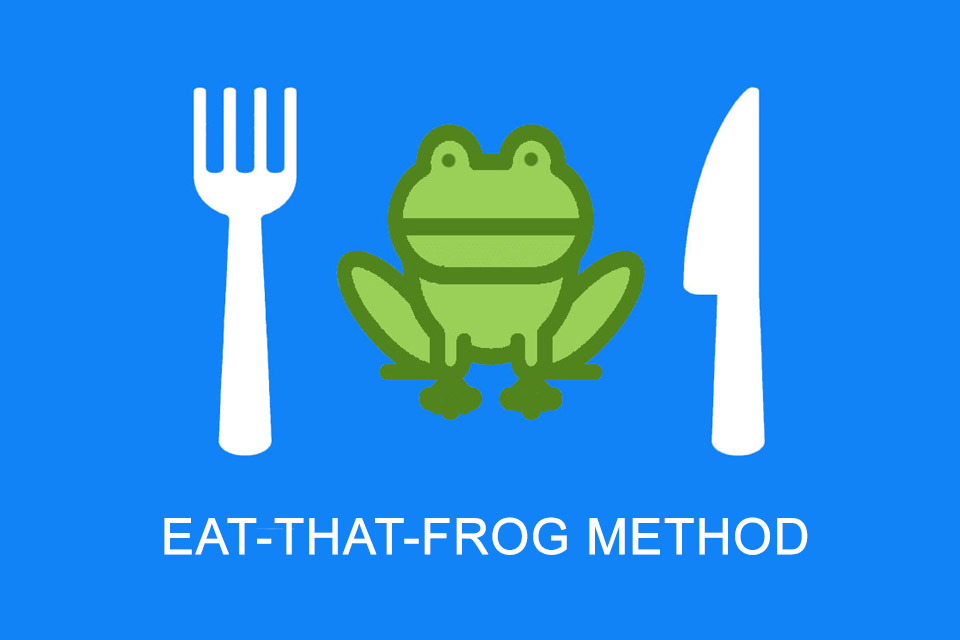What is the Eat-that-Frog Method?
Smartpedia: The Eat-that-Frog method is a time management technique whereby the most important, difficult and possibly unpleasant task of the day – for example, eating a frog – should be done first.
Eat-that-Frog Method – get the most important things done first
“Eat a live frog first thing in the morning and nothing worse will happen to you the rest of the day.” Mark Twain is said to have once formulated. Many people, without ever having eaten a live frog, will agree with this assumption. One of them is certainly Brian Tracy. In his book of the same name, he popularised the Eat-that-Frog method as a time management technique.¹
The idea of the method is to give priority to the most important, most difficult and possibly most unpleasant task of the day (“eat a live frog”) and to do it first thing in the morning in order to maximise productivity and prevent procrastination.
Prerequisites for Eat-that-Frog
There are a number of prerequisites for Eat-that-Frog to succeed, which Brian Tracy explains with the help of various quotes in his book. Below you will find a small selection:
Clarity as the most important concept of personal productivity
“There is one quality without which you cannot win: Goal orientation, knowing what you want and a burning desire to achieve it.” – Napoleon Hill.
Clarity prevents vagueness and confusion. The more clarity one has about what one wants and what one needs to do to achieve it, the easier it is for the person to overcome the tendency to procrastination and “eat the frog” or complete the potentially unpleasant task.
Putting pressure on oneself
“The first condition of success is to direct one’s physical and mental energies unceasingly to a single problem without tiring.” – Thomas Alva Edison
People need to develop a habit of putting pressure on themselves. No one will come to take on unpleasant tasks. The key is to consistently identify the “frogs” and then eat them in order of importance – with self-imposed pressure if necessary.
Considering the impact – a key factor
“Every man has become great, has succeeded, to the extent that he has limited his powers to a particular channel.” – Orison Swett Marden
The potential impact of a task is the key factor in its importance. By looking at these impacts, it is possible to work out which ‘frog’ is next, with long-term thinking in particular improving short-term decisions.
Overall, Brian Tracy describes 21 ways for effective, productive people to discipline themselves to always start with the most important task and force themselves to eat the frog, regardless of what it looks like.
The process of the Eat-that-Frog Method
The process or application of the method is quite simple:
- Make a list of all the tasks that need to be done, ideally already at the end of the lecture for the following day.
- Order the tasks according to importance and urgency.³
- Start working on the most important task and focus on it until it is done.
- Move on to the next task and continue until all tasks are done or until the end of the day.
Obviously, this is an ideal sequence of events, which is also propagated by many other approaches to time management, such as the Ivy Lee Method or the 80-20 rule. In order for the technique to actually have an effect, it can be useful to deal with a few other aspects in the specific context:
- What is the agreed objective? Perhaps there is a product goal to be achieved, perhaps a common scope has been defined? The answers to such and similar questions provide orientation for the selection and completion of activities.
- What excites our customers? What do stakeholders want? Which services or features are really needed and paid for and which go in the direction of gold plating?
- How can I best contribute my skills as an individual (and part of a team) now, what helps my colleagues, what has been agreed, what offers the most benefit or what deadline is looming?
Criticism of the Eat-that-Frog Method
Like many other approaches to time management, the Eat-that-Frog Method is not a panacea. It may help some people to work more effectively, but it is certainly not suitable for everyone, as people have different working styles and preferences.
If one understands the method not only as an approach to prioritising and completing important tasks, but as the result of the 21 ways described by Brian Tracy in his book, the approach unfolds a completely different scope.
The book describes a procedure and recommends, for example, the creation of daily, weekly and monthly lists. Structuring projects in terms of content is certainly a useful and proven practice. However, the book says: “For each project, you should start by making a list of all the steps you need to complete to get it done from start to finish”. And, “The more time you take to make written lists in advance of everything you need to do, the more effective and efficient you will become.”
The book thus describes a procedure in which all the steps of a project are clear in advance. This means that the procedure is not really suitable for projects which, following DIN 69901², are essentially characterised by uniqueness and therefore cannot clearly name all the steps in advance. But even if there are projects in real life that are not one-off, the statements certainly do not fit agile projects where changes are the order of the day and many aspects of a product to be developed only emerge over time.
Furthermore, the book outlines a view of human beings that simply does not apply to many people: “Successful people are always willing to wait for the reward and make sacrifices in the short term so that they will be rewarded much better in the long term. Unsuccessful people, on the other hand, think more about short-term pleasures and immediate rewards, but hardly about the long-term future.”
In addition, the book comes up with numerous unsubstantiated statements: “Otherwise, clear your desk completely so that the next morning only this one, most important task sits on it, waiting for you like a big frog. If you do this every day for three weeks, it will become a habit. By doing this, you can double your productivity in less than a month!” Why?
Or: “On the days when you immediately throw yourself into your most important task, you will feel better, stronger and more effective about yourself and your work than usual. You will feel you have more control over your life.” Aha, one can of course claim, but is unlikely to apply to all people.
Conclusion: Eat-that-Frog has a funny name, unless you are a frog. In terms of content, it is a time management technique according to which the most important, most difficult and possibly most unpleasant task of the day should be done first. Unfortunately, Brain Tracy’s derivations are rather general and therefore do not seem particularly well-founded.
Impulse to discuss
What could evidence look like to prove that doing the most important task of the day first is more efficient and effective?
If you like the article or would like to discuss it, please feel free to share it in your network. And if you have any comments, please do not hesitate to send us a message.
[1] Brian Tracy: Eat that Frog. A book with 21 ideas to increase personal efficiency and effectiveness.
[2] DIN 69901
[3] A look at the Eisenhower Matrix might be worthwhile here, as it helps distinguish between important, unimportant, urgent and non-urgent tasks.
Here you will find additional information from our t2informatik Blog:



